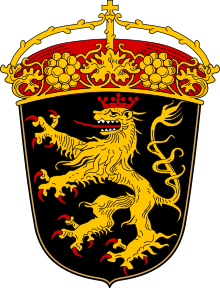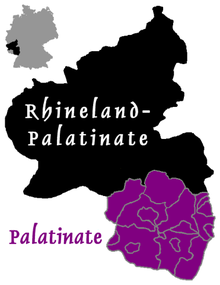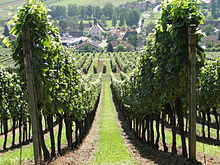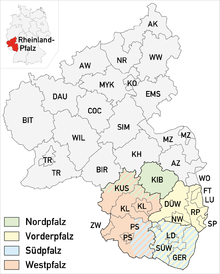This is an old revision of this page, as edited by 2003:60:4c69:abd6:9900:e095:970b:8058 (talk) at 10:02, 26 July 2016 (→Cuisine: Fixed Typos). The present address (URL) is a permanent link to this revision, which may differ significantly from the current revision.
Revision as of 10:02, 26 July 2016 by 2003:60:4c69:abd6:9900:e095:970b:8058 (talk) (→Cuisine: Fixed Typos)(diff) ← Previous revision | Latest revision (diff) | Newer revision → (diff) For other uses, see Palatinate (disambiguation).| This article needs additional citations for verification. Please help improve this article by adding citations to reliable sources. Unsourced material may be challenged and removed. Find sources: "Palatinate" region – news · newspapers · books · scholar · JSTOR (January 2013) (Learn how and when to remove this message) |

The Palatinate (Template:Lang-de, Pfälzer dialect: Palz), historically also Rhenish Palatinate (Template:Lang-de), is a region in Southwestern Germany. It occupies more than a quarter of the German federal state of Rhineland-Palatinate (Rheinland-Pfalz) covering an area of 5,451 square kilometres (2,105 sq mi) with about 1.4 million inhabitants. Its demonym is Palatine.
Geography

In the west, the Palatinate borders on Saarland, historically also comprising the state's Saarpfalz District. In the northwest, the Hunsrück mountain range forms the border with the Rhineland region. The eastern border with Hesse and the Baden region runs along the Upper Rhine River, while the left bank with Mainz and Worms as well as the Selz basin around Alzey belong to the Rhenish Hesse region. In the south, the German-French border separates the Palatinate from Alsace.
One third of the region is covered by the Palatinate Forest (Pfälzerwald), including the Palatinate Forest Nature Park popular with hikers. It is Germany's largest contiguous forestal area with about 1,771 km (684 sq mi) and part of the Franco-German Palatinate Forest-North Vosges Biosphere Reserve.
The western and northern part of the Palatinate is densely forested and mountainous. Its highest mountain is the Donnersberg with a height of 687 m (2,254 ft), situated in the North Palatine Uplands near Kirchheimbolanden. Most of the major Palatinate towns (Ludwigshafen, Speyer, Landau, Frankenthal, Neustadt) lie in the lower eastern part of the Upper Rhine Plain down to the Rhine River. Here the German Wine Route (Deutsche Weinstraße) passes through the renowned Palatinate wine region.The Palatinate is one of the greatest wine producer regions in Germany and in the last two decades it became well known for a large number of prizewinning white and red wines of highest quality produced by a number of young, however fully-fledged, winemakers.



Major rivers include the Upper Rhine tributaries Lauter, Queich and Speyerbach, as well as Schwarzbach and Glan in the west.
Historically the Electoral Palatinate and several other territories were part of the Palatinate, but today belong to other German territories.
Subdivision

The Palatinate is divided into four non-administrative sub-regions, comprising the following rural districts and independent cities:
- North Palatinate (Nordpfalz), i.e. the sparsely inhabited North Palatine Uplands, made up of
- Donnersbergkreis (KIB), including the small towns of Eisenberg, Kirchheimbolanden and Rockenhausen
- Anterior Palatinate (Vorderpfalz) between Upper Rhine and the Haardt range of the Palatinate Forest
- Bad Dürkheim (DÜW)
- Rhein-Pfalz-Kreis (RP)
- and the cities of Frankenthal (FT), Ludwigshafen (LU), Neustadt an der Weinstraße (NW) and Speyer (SP)
- South Palatinate (Südpfalz).
- Germersheim (GER)
- Südliche Weinstraße (SÜW)
- and the city of Landau (LD)
- West Palatinate (Westpfalz) up to the western part of the North Palatine Uplands
- Kaiserslautern (district) (KL)
- Kusel (KUS)
- Südwestpfalz (PS)
- and the cities of Kaiserslautern (KL), Pirmasens (PS) and Zweibrücken (ZW).
Climate

Like most of Europe, the Palatinate is part of the oceanic climate zone influenced by the Atlantic, with an average annual temperature of about 10 degrees Celsius. Wet air streaming from West and Southwest leads to precipitations in the Mittelgebirge ranges, while it warms up on its way further down to the Rhine Valley. Here the clemency of the weather permits the cultivating of almond and fig trees, stone pines, Mediterranean Cypress, palms, and even some banana species. The lower hilly regions are known for its extended chestnut forests, sometimes referred to as "German Tuscany" in tourist advertising.
History
The former Celtic region was conquered by the Roman Empire under Emperor Augustus about 12 BCE, whereafter it was part of the Germania Superior province. During the decay of the Empire, Alamanni tribes settled here; their territory was conquered by Francia under King Clovis I about 496. From 511 onwards the area belonged to the eastern part of Frankish Austrasia, that—as Rhenish Franconia—became part of East Francia according to the 843 Treaty of Verdun.
Holy Roman Empire
From the Middle Ages until 1792, the Palatinate was divided into a total of 45 secular and ecclesiastical territories, some of which were very small. The largest and most important of these was the Electorate of the Palatinate (Kurpfalz), a number of territories on both sides of the Rhine formerly held by the Counts palatine (Pfalzgrafen) of Lotharingia. In the late 12th century the Counts palatine had achieved the status of a Prince-elector (Kurfürst), i.e. one of the seven nobles with the privilege of electing the Emperor, confirmed by the Golden Bull of 1356. In 1214 the Bavarian House of Wittelsbach was enfeoffed with these estates, which they ruled until 1918, together with the collateral branch of Palatinate-Zweibrücken from 1410, until the re-unification with Bavaria under Elector Charles Theodore in 1777. The major ecclesiastical territory in the region was the Bishopric of Speyer. The Imperial city of Landau to preserve its status joined the Alsacien Décapole in 1521. Nevertheless, it was seized by France after the Thirty Years' War.
Other larger entities of the region were the Duchy of Zweibrücken and the Prince-Bishopric of Speyer. The Prince-Bishopric also had possessions on both sides of the Rhine. For centuries, Electoral Palatinate and Bavaria had had dynastic links through the Wittelsbach family.
French rule
In 1794, the Left Bank of the Rhine, including the Palatinate, was occupied by French revolutionary troops. As a result of the Treaty of Campo Formio (1797) the First French Republic annexed the region and introduced a new administrative system in 1798 with the establishment of departments. Basically, the area of the Palatinate became the Département of Mont Tonnerre laying the corner stone for today's regional idendity. Minor parts of today's region belonged to the neighbouring departements of Sarre and Bas-Rhin. The French further subdivided the department into cantons, mayoralties and municipalities and introduced their legal system (Napoleonic Code) and the metric system.
Bavarian rule
Following the defeat of Napoleon at the Battle of Leipzig in 1813 and the capture of the Left Bank of the Rhine by the Allies in January 1814, from 2 February 1814 the region was initially under the provisional authority of the General Government of the Middle Rhine, but, from 16 June that same year, it was placed under the administration of the Imperial-Royal ("k.k.") Austrian and Royal Bavarian Joint Land Administration Commission (k. k. östreichischen und k. bairischen gemeinschaftliche Landes-Administrations-Kommission).
In the main treaty agreed at the Congress of Vienna in 1815, and dated 9 June 1815, Article 51 stated that (inter alia) on the Left Bank of the Rhine the former departements of the Sarre and Mont Tonnerre, except where stated in the same treaty, were to go "with full sovereignty" and ownership rights under the overlordship of the Emperor of Austria (Herrschaft Sr. Maj. des Kaisers von Oesterreich). The joint Austro-Bavarian administration was initially retained, however.
On 14 April 1816, a treaty was signed between Austria and Bavaria, in which the various territorial changes were agreed. According to Article 2 of the treaty, Emperor Francis I of Austria ceded various regions to King Maximilian I of Bavaria. These included, in addition to various regions east of the Rhine, the following regions west of the Rhine:
- In the Departement of Mont Tonnerre (Donnersberg):
- the districts of Zweibrücken, Kaiserslautern and Speier; the latter with the exception of the cantons of Worms and Pfeddersheim;
- the canton of Kirchheim-Bolanden, in districts of Alzei.
- In the Sarre Departement:
- the cantons of Waldmohr, Blieskastel and Kusel, the latter with the exception of several villages on the road from St. Wendel to Baumholder, which were to be compensated, by another territorial transfer, with the agreement of the assembled plenipotentiaries of the allied powers at Frankfurt.
- In the Departement of Bas Rhin:
- the canton, town and fortress of Landau, the latter as a federal fortress in accordance with the regulations of 3 November 1815;
- the cantons of Bergzabern. Langenkandel and the whole part of the Departement of Bas Rhin on the left bank of the Lauter, which had been ceded in the Paris Tractat of 20 November 1815.
The effective date for these changes was stated as 1 May 1816.
In accordance with the prevailing Bavarian administrative structure, the region became one of 8 Bavarian districts (Kreise). As of 1808, Bavaria had embarked on the administrative reorganization of its territory creating districts which, as in France, were named after their main rivers. Thus, the new district along the Rhine was given the name Rheinkreis (Rhine district) with Speyer as its capital. Of the former French administrative structure, the subdivision of the district into arrondissements, cantons, mayoralties and municipalities was basically retained. The Bavarian government also preserved the French legal system (Code Napoléon), giving the Palatinate a distinct legal status within the Bavarian kingdom. At the next lower level the 3 former French arrondissements were continued as “Kreisdirektion” (Circle, i.e. district direction) Frankenthal, Kaiserslautern and Zweibrücken. The Kreisdirektion Landau was a new creation. In 1818, the cantons were mergen into 12 administrative districts called “Landkommissariat”. The names of these were changed into “Bezirksamt” in 1862 and finally into “Landkreis” (rural district) in 1939. As his first provincial governor, King Maximilian selected the Privy Councillor (Hofrat) Franz Xaver von Zwack, whose name is responsible for the popular Palatinate nickname for Bavarians, Zwockel. In 1832, the Rheinkreis became the focal point of the liberal movements of the time when a big gathering, the Hambach Festival took place near Neustadt an der Weinstraße which is considered a milestone in German history.
In 1835, the romantic-minded King Ludwig I of Bavaria ordered the administrative districts of Bavaria to be named by historical allusions. So the Rheinkreis officially became the Pfalz (Palatinate). It should be noted here, that the historic Electorate of the Palatinate was on both sides of the Rhine with Heidelberg and Mannheim as its capitals on the eastern side, while the new "Palatinate" that was established in 1815/16 was solely on the left bank of the Rhine, and included territories that had never been part of the historic Palatinate (e.g., territories of the former Bishopric of Speyer, the imperial city of Speyer or Kirchheimbolanden, which had formerly belonged to the Weilburg branch of Nassau). In order not to confuse the new Palatinate with the historic one (and with the Upper Palatinate), the name Rhenish Palatinate (Rheinpfalz) became common and is still used today, but never official. The term Rhenish Bavaria (Rheinbayern) never gained currency but can be found sometimes in older maps.
The royal family tried to symbolize the unity with Bavaria by erecting a royal palace in Edenkoben and by the restoration of Speyer Cathedral under direct supervision of King Ludwig I himself. The new town of Ludwigshafen was named after the king. On the other hand, the Palatinate's representatives to the common Bavarian Parliament always prided themselves of their origin from a more progressive region and tried to expand the liberalism, which the French had introduced in the Palatinate, to the whole kingdom. The German historian Heiner Haan described the special status of the Palatinate within Bavaria as a relation of "Hauptstaat" (main state, i.e. Bavaria) and "Nebenstaat" (alongside state, i.e. the Palatinate).
In May/June 1849, after the failed revolution of 1848 and as part of the Imperial Constitution campaign a separatist wanted the district to secede from Bavaria and establish a "Palatinate Republic". The uprising was suppressed by Prussian military intervention. The union with Bavaria persisted after it became part of the German Empire in 1871, and even after the Wittelsbach dynasty was deposed and Bavaria became a free state of the Weimar Republic in 1918. In 1910, the town of Landau was declared independent from the Bezirksamt.
However, after World War I French troops occupied the Palatinate under the terms of the Treaty of Versailles. In 1920, the western Bezirksämter of Sankt Ingbert and Homburg (Saarpfalz) were separated from the Bavarian Palatinate and became part of the newly established Saarland, which according to peace treaty was governed by the League of Nations.That same year, 7 more towns were declared independent from the Bezirksämter: Speyer, Ludwigshafen, Frankenthal, Neustadt an der Weinstraße, Kaiserslautern, Pirmasens and Zweibrücken. They have remained independent to this very day.
In 1919 and 1923, during the occupation, there were attempts at separating the Palatinate from Bavaria and the Empire supported by the French. On 1 June 1919, Eberhard Haaß, founder of the “Free Palatine Association” in 1918, proclaimed the “Palatine Republic” but failed to occupy the government building in Speyer. On 23 November 1923, Franz Josef Heinz proclaimed the "Government of the Autonomous Palatinate in the Association of the Rhenish Republic" in Speyer after having gained control of the towns of Kaiserslautern, Neustadt and Landau and after capitulation of the Palatine government. In the following days several more towns fell into the hands of his group. The Bavarian government reacted sharply. It organized a squad under the command of Edgar Julius Jung and on 9 January 1924 Heinz was assassinated while dining at the Wittelsbacher Hof in Speyer. On 12 February 1924, other leading members of the separatist movement were killed in a shooting in Pirmasens. By then, a treaty between Bavaria and the inter-allied commission of the Rhineland (the supreme council of the Allied occupation forces) of January 1924 recognised and reassured the Palatinate being a part of Bavaria and spelled the end of the separatist movement.
Under Nazi rule, from 1933 to 1945, the Palatinate officially remained part of Bavaria but else was totally reorganized. Under party rule it was joined with the Saarland to the Gau Westmark with headquarters in Saarbrücken.
Rhineland-Palatinate
The union with Bavaria was finally dissolved following the reorganisation of German states after World War II during the Allied occupation of Germany. Whereas proper Bavaria was part of the US occupation Zone, the Palatinate was occupied by French Forces. The French reorganised their occupation Zone by founding new states and in 1947, the Palatinate was combined with Rhenish Hesse (Rheinhessen), the former parts of the People's State of Hesse left of the Rhine, and the southern part of the Prussian Rhine Province to form the German federal state of Rhineland-Palatinate. The Palatinate formed the administrative district (Regierungsbezirk) Pfalz. This reorganization came with smaller lossess of former district territory to the Saarland, especially in the area of Sankt Wendel. As part of the 1969 administrative reform there were again some minor border changes in the north. The Diocese of Speyer and the Evangelical Church of the Palatinate still exist today largely based on the historic boundaries of the Bavarian district Pfalz.
Initially one of 5 districts in Rhineland-Palatinate, in 1968, the district of Pfalz was merged with the neighbouring district of Rheinhessen to the district of Rheinhessen-Pfalz. On 1 January 2000, all administrative districts of Rheinland-Pfalz were dissolved.


Emigration
The Pennsylvania Dutch language spoken by the Amish in the United States is derived primarily from the German dialect spoken in the Palatinate, which many Palatine refugees brought to Pennsylvania in the early decades of the 18th century. The only existing Pennsylvania German newspaper, Hiwwe wie Driwwe is published bi-annually in the village Ober-Olm, which is located close to Mainz, the state capital (as a cooperation project with Kutztown University). In the same village, one can find the headquarters of the German-Pennsylvanian Association.
Cuisine
See also: Palatinate (wine region)| This section needs expansion. You can help by adding to it. (March 2010) |
Arguably the most famous dish in Palatinate is the Saumagen, literally "sow's stomach", a dish that consists of a thick, crispy-fried casing (sow stomach) stuffed with a mixture of pork, potatoes, and seasonings. Other traditional meat dishes of the region include bratwurst, Palatinate liverwurst, a blood pudding sausage called Grieweworscht ("Griewe" are speck (bacon) cubes, so lit. "sausage with speck cubes"), Lewwerknepp or Lewwerknedel (Leberknödel: liver dumplings), and Fleeschknepp (Fleischknödel: meat dumplings). Sauerkraut is the typical side dish in all seasons, but especially in winter, as are mashed potatoes and brown gravy. Also eaten are Dampfnudeln, which can be served with either sweet sauces or side dishes (such as wine, vanilla sauce or canned fruit such as plums, prunes, or pears) or with savory side dishes (such as potato soup, vegetable soup, goulash, or pepper pork).
See also
- Palatinate (disambiguation)
- Palatinate Forest
- Palatine German language
- Palatinate (wine region)
- German Wine Route
- Hiwwe wie Driwwe
References
- Adalbert Heib: Beamtenverzeichniß und Statistik des Königlich Bayerischen Regierungs-Bezirkes der Pfalz, Speyer, Kranzbühler, 1863, pp. 58 ff (Online)
- F. W. A. Schlickeysen: Repertorium der Gesetze und Verordnungen für die königl. preußischen Rheinprovinzen, Trier: Leistenschneider, 1830, pp. 8 ff. (Online)
- Haupt-Vertrag des zu Wien versammelten Congresses der europäischen Mächte, Fürsten und freien Städte, nebst 17 besondern Verträgen, Article 51, p. 101 (digitalised)
- Treaty of Munich dated 14 April 1816 in G. M. Kletke: Die Staats-Verträge des Königreichs Bayern ... von 1806 bis einschließlich 1858, Regensburg, Pustet, 1860, p. 310 (Online)
- "Forschung - Universität Regensburg". Uni-regensburg.de. Retrieved 2012-09-09.
External links
- Rhenish Palatinate – Catholic Encyclopedia article
49°26′N 7°46′E / 49.433°N 7.767°E / 49.433; 7.767
Categories: